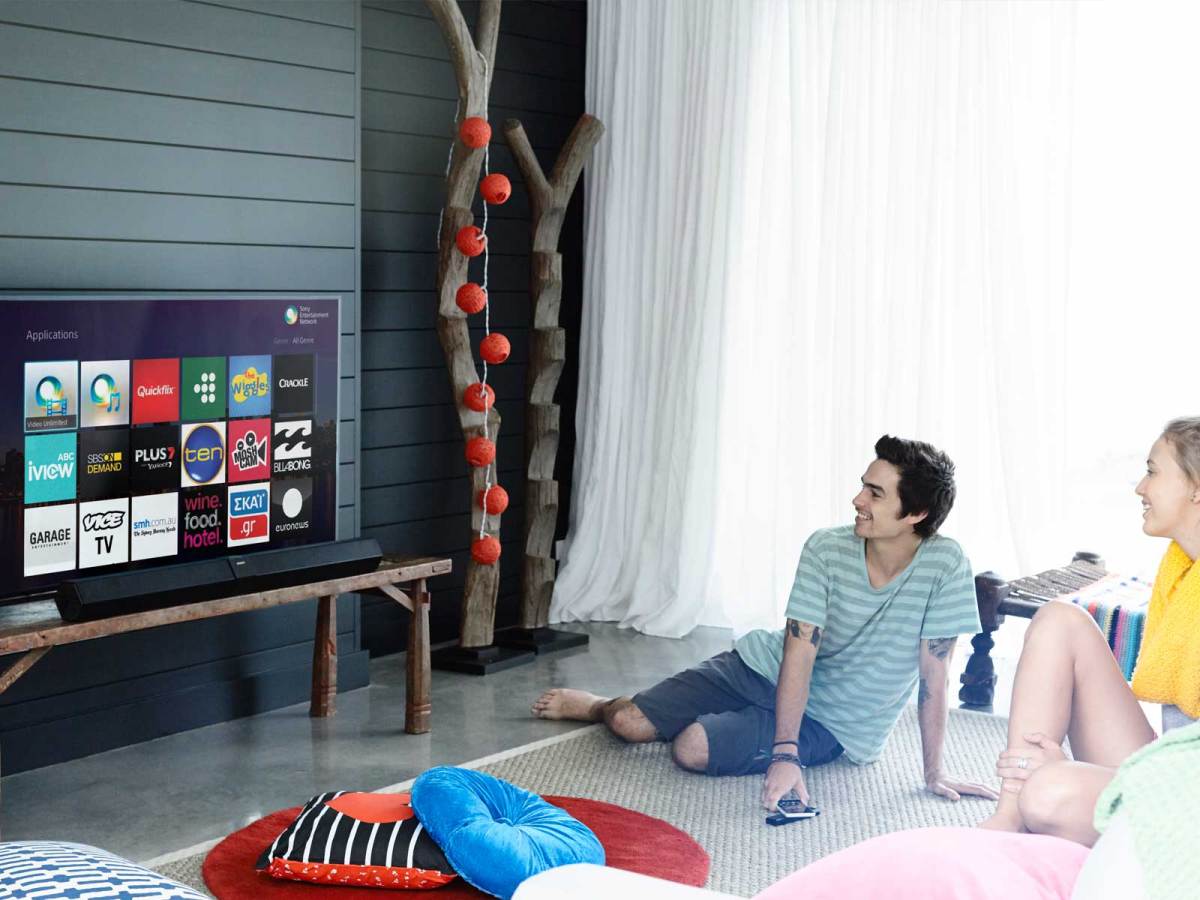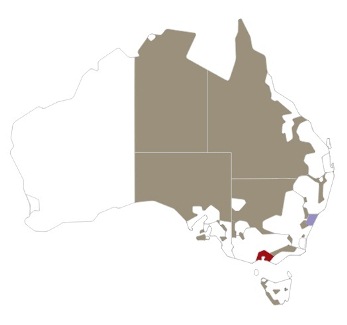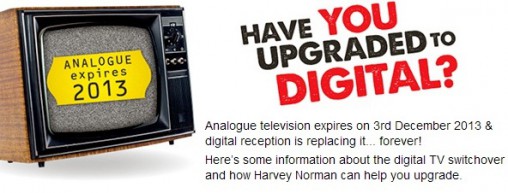An era that began with Melbourne hosting the first Southern Hemisphere Olympic Games in 1956, included Kennedy and J.R. both being shot in Dallas, Australia winning the America’s Cup, Princess Diana’s funeral and her son’s wedding, and the finale of MasterChef Australia’s second season* will come to a close next month as Sydney, Melbourne and remote Australia switch off analogue TV forever and move holus-bolus to digital transmissions.
Sydney’s switchover date is Tuesday 3 December 2013, while Melbourne and remote Australia is switching over is on Tuesday 10 December 2013. This map shows what areas are affected:
Television first came to Australia on 16 September 1956, 27 years after trials began in Melbourne and 30 years after John Logie Baird’s groundbreaking demonstrations. The technology was rushed into Australian homes so the Olympic Games, beginning in November, could be broadcast into Melbourne and Sydney.
The first two cities to receive the transmission will also be the last. Over the past three years, Australia has been systematically switching off analogue signals, with TV viewers forced to move to one of several new and newish technologies, chiefly digital TVs, personal video recorder (PVRs) and digital set top boxes.
According to figures released by the Communications Minister Malcolm Turnbull, there are still over 100,000 households in Sydney that need to make the switch. Turnbull also noted that for the purposes of this project, ‘Sydney’ includes outlying areas such as the Central Coast, the Blue Mountains and semirural southwest.
“The Sydney switchover area includes Gosford, Katoomba and Picton, with over 1.7 million households making the switch,” Turnbull said. “Already, over 94 per cent of households have converted to digital TV since it became available across Sydney in 2001.
“If you haven’t yet switched from analogue to digital TV, please don’t put it off any longer.”
The switch-off process has mostly been quite smooth – a credit to the former communications minister, Senator Stephen Conroy – with only an hubbub over the Household Assistance Scheme, a set top box subsidy program, causing much uproar.
Essentially, the former Rudd-Gillard Governments set aside just over $300 million to pay for some Australians to receive a free set top box, including installation, a demonstration and a warranty. Based on the number of eligible Australians – mainly senior citizens – this worked out to be around $350 per household: too much according to some commentators.
With price erosion and consumer confidence low, retailers have certainly welcomed the digital switchover as it rolled across the country. When we spoke with Betta Home Living’s Broadbeach store after southeast Queensland made the switch on 28 May 2013, Chris Lebreton reported strong feedback.
“It’s absolutely been positive in regards to TV sales, there’s certainly been a spike in that,” he said. “Everyone wants a bigger and better TV now. People might have had a 32-inch LCD which is about five years old now. So customers that got those TVs when they first came out will probably…opt for a 50-inch model, because the prices have changed since five years ago.”
With so many people being affected by the upcoming switch, several major suppliers have taken an active role in promoting how their products can assist affected TV viewers. Sony Australia is currently promoting the switchover on its homepage, as is Panasonic Australia, while news of the switchover is missing from the LG and Samsung homepages.
Obviously not all the households in Sydney and Melbourne will require new hardware purchases; any home with an existing digital TV or set top box (including Foxtel and Austar) will not experience any interruption. While it is impossible to know the exact amount of analogue TV viewers being forced back into the market, most believe it is a sizable minority — enough to create a noticeable spike — including Alistair Robins, the group marketing manager for AV at Panasonic Australia.
“We’re expecting a large increase in demand for not only TVs but also for Blu-ray and DVD recorders, which suit those customers who don’t want to purchase a new television just yet or want to replace their old recorder,” Robins said.
“During the digital switchover in other cities, such as Brisbane, we saw the market for recorders nearly double in sales, compared to the previous period. In fact, Queensland went from being the third biggest state for sales to the number one state, overtaking New South Wales in terms of units sold.”
Robins said retailers should be on alert for consumers that have been taken unawares by the switchover; those coming into a store because they have recently read an article or seen an advertisement about the switch, and, in extreme cases, those customers whose old TVs simply stopped broadcasting.
“Customers are looking to replace both recorders and TVs and there’s a good opportunity to sell them a product that will best suit their needs, rather than just a cheap set top box,” Robins said. “Retailers should be prepared with plenty of stock as the customer will want an immediate solution.”
Retailers should be especially careful not to mislead any customer regarding the switchover, however, as the Australian Competition and Consumer Commission (ACCC) has made it clear it is on the lookout for any organisation peddling misinformation about the changes. It is important that retailers and staff do not exaggerate the scope of switch (for example, telling a customer they must purchase new TV) or provide misinformation regarding the Household Assistance Scheme (for example, telling a customer that the government will reimburse a purchase).
“[The] switchover to digital television is ripe for scams,” said an ACCC SCAMwatch spokesperson. “Scammers selling digital conversion equipment are targeting communities with the promise of a government reimbursement for any goods purchased. The government has advised that there are no reimbursements for digital television goods or services bought from any retailers, including door-to-door salespeople.”
Harvey Norman is one retailer making an effort to capture its share of switchover sales, sending emails to its database last week promoting set top boxes, personal video recorders and TVs for the change.
In an email specifically sent to its Sydney subscribers, Harvey Norman gave several reasons why consumers should upgrade:
“Analogue TV reception will cut off by 3 December 2013. To continue watching free TV, you’ll need to get ‘Digital Ready’. There are also great benefits of switching to digital Television, including:
- Clear reception and sharp picture quality
- New TV channels as well existing ones, plus digital radio
- Electronic Program Guide
- Television and movies in 16:9 widescreen.”
Harvey Norman’s email included special deals for the switchover including Topfield set top box for $32, an LG 500GB Blu-ray recorder for $286 and a 32-inch Toshiba TV for $296.
Dick Smith is also taking an active approach, dedicating a webpage to an admirably comprehensive guide to the switch and promoting it on the national retailer’s homepage:
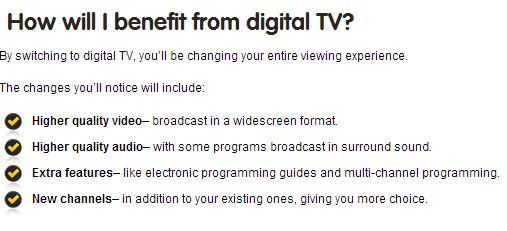
- Dick Smith is promoting the switchover.
Sydney retailer Bing Lee is also doing a good job communicating the switchover to customers, telling them to “put away their PANIC button” and providing a handy FAQ page, answering questions like, ‘can I still use my pre-digital flat panel TV after the switchover?’:
Definitely, and you will also see a vast improvement in the picture quality. All you will need is a set top box or PVR with a digital receiver built-in. This will be able to connect to your TV and deliver the broadcasts you’re used to watching along with a host of additional content.
One retailer that appears to be missing a trick here is JB Hi-Fi. Although this popular electronics retailer has many, many stores in Sydney and Melbourne, along with a transactional website, there is no mention of the switchover on its homepage, or elsewhere on its website, when we searched for it today.
UPDATE: At 4:44pm this afternoon, I received a promotional email from JB Hi-Fi promoting the switchover and advertising TVs by its de facto house brand Soniq:
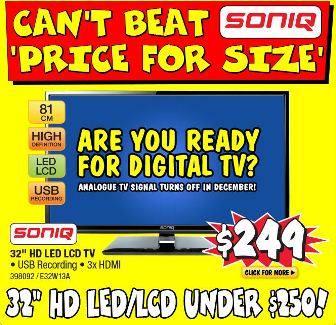
With so many legacy television sets soon becoming unattractive household curiosities, the focus shifts to how to dispose of the old analogue units. The great Australian tradition of leaving ol’ faithful out on the nature strip needs to be dispensed with for good, according to TechCollect, one of three licensed TV recyclers in Australia.
TechCollect, along with DHL and E-Cycle Solutions, are funded by all TV importers are charged with collecting old TVs and transporting them for recycling. Televisions simply abandoned on the street can pose a danger if the glass breaks or if people come into contact with dangerous materials (more of a concern with particularly old models). Even if the TVs do make it off the street in one piece, they will continue pose a danger to the environment if they end up in landfill instead of being recycled.
“Electrical and electronic products contain a complex mix of materials, components and substances,” said a TechCollect spokesperson. “Once dismantled, some components in televisions and computers are classed as hazardous. They include substances such as mercury, lead, cadmium, beryllium, chlorine, bromine and phosphors.”
“The sorting stations for most household recycling aren’t equipped to handle electrical items as it requires specialist disposal technology in order to meet the strict OHS guidelines. As a result, electrical items found in kerbside recycling bins tend to be sent to landfill.”
To help consumers dispose of their old televisions responsibly, TechCollect, DHL and E-Cycle have established collection points throughout Australia to receive old TVs, as well as old computers and peripheral computer hardware. Consumers should note that although these three recyclers have associations with specific brands (TechCollect with Panasonic and DHL with Sony, for example), all three will accept TVs from any brand.
TechCollect and DHL (‘DropZones’) have comprehensive collection site information on their websites, while E-Cycle does its collections predominantly from electrical retailers. Many electrical retailers operate as shop fronts for these recyclers; consumers should call ahead to find out if their store offers this service.
*Australia’s all-time most-watched episode of regular television programming.

